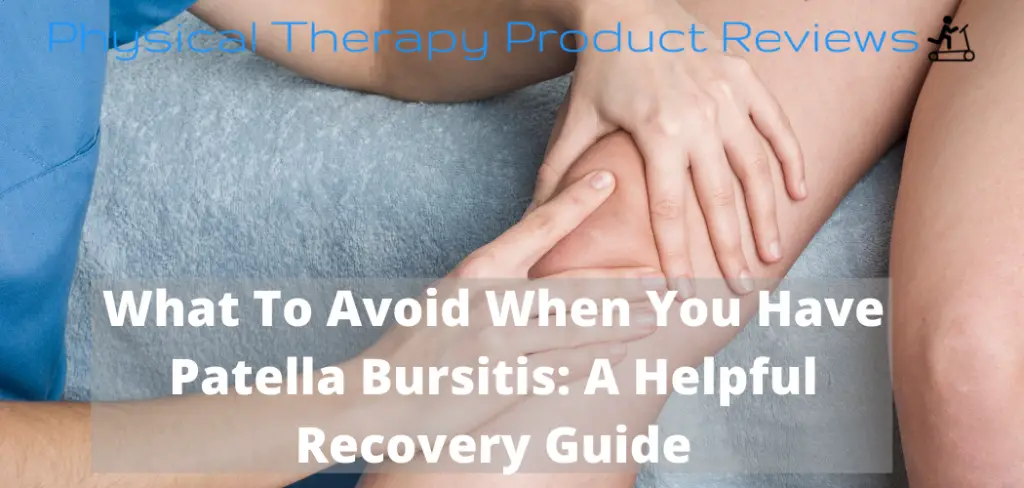If you are suffering from Patella Bursitis, then you know how painful and debilitating the condition can be. You may be having a hard time recovering because you continue to aggravate the bursa and it can like you aren’t making any progress.
In this blog post, we will discuss some of the things that you should avoid in order to speed up recovery including reducing inflammation and improving your pain levels.
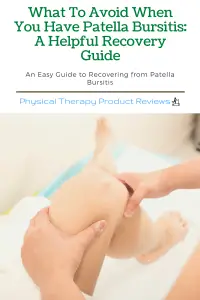
In addition, you may be wondering what you can do to speed up your recovery. We also cover some helpful tips to help you get back on your feet sooner and do things that give you a higher quality of life.
What is Patella Bursitis?
Patella bursitis is a condition that results in pain, inflammation, and tenderness at the patellar bursa. This small, fluid-filled sac sits just below the patella (kneecap) and helps to cushion and lubricate the area against the friction of moving bones and tendons.

The patellar bursa can become inflamed for a variety of reasons, including:
- kneeling for prolonged periods of time
- repetitive motions or a sudden increase in activity above your normal activity level
- surgery or trauma to the area
- Landing or a high force contact on the bursa such as a contusion
Symptoms of Patella Bursitis
The most obvious symptom with patella bursitis is pain and tenderness to touching or putting pressure on the kneecap area. There may be redness, swelling, and a burning sensation that doesn’t seem to go away unless you use ice or medication. Don’t worry, this does get better.
Other symptoms of patella bursitis include:
- pain and inflammation around the kneecap
- swelling and warmth over the bursa sac and front of the knee
- difficulty with knee movement especially bending the knee
- discomfort when you kneel, squat, or climb stairs
What Should you Avoid If you Have Patella Bursitis?
Now that we have an understanding of what patella bursitis is, let’s take a look at what you should avoid if you are on the path to recovery.
Being Sedentary
This may seem like the last thing that you want to do when you are in pain, but staying active will actually help to speed up your recovery.
Try to find activities that don’t aggravate your symptoms such as swimming, walking, and even light weight lifting training.

Try to slowly add more activity as you start to feel better and it’s important not to baby the knee.
Kneeling
When you are kneeling, you are placing direct pressure on the patellar bursa, which can cause further irritation.
If you must kneel, try to use a cushion or pillow for support between the ground and your knee.
There are also knee pads that you can wear if you have a job where you have to kneel a lot during the day such as a plumber or a kindergarten teacher.
Lifting Heavy Weights
Lifting weights can put a lot of stress on the patellar bursa and may aggravate your symptoms.
Try to stick to body-weight exercises until you start to feel better, especially on leg exercises.
Lunges, mini squats, and knee extensions are all exercises that are good to do if there is minimal to no pain and no change in swelling after.
Repetitive Deep Squats
Squats are a great exercise, but if you are suffering from patella bursitis, deep squats may not be the best choice for you at this point.
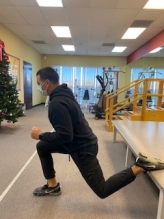
Try doing split squats or wall sits instead and increase your repetitions but don’t go as deep. The deeper you go into the squat position the more pressure that gets placed on the bursa.
Repetitive Motions
Doing the same activities over and over can cause irritation to the bursa, especially if it involves stairs, squatting, or kneeling.
Watch out for these repetitive motions that may not cause pain right away but increase symptoms after a few minutes or later that evening once you’re done with the activity.
Look for ways to modify work so that you can reduce the amount of repetitive motion under load that you can.
How Long Does Knee Bursitis Last?
Patella bursitis can vary in duration, depending on the cause and severity of the condition.
In most cases, patellar bursitis will resolve within a few weeks with appropriate treatment. However, in some cases, it may take months to fully recover.
Most Patella Bursitis resolves within 3-4 weeks, however, we do see severe cases that cases take up to 5-6 months to fully heal.
You may have tenderness on the front of the knee with kneeling for quite some time, up to 6 months, even though you feel normal in nearly every activity otherwise.
It can feel as slow you’re not making any progress at times due to the slow pace of recovery, but be patient, it will continue to heal.
Can You Run With Patella Bursitis?
Running is a great way to stay active, but if you are suffering from patella bursitis, running may not be the best choice for you.
The repetitive force through the Patella Tendon and Bursa may be too much and cause an increase in pain and swelling.
As an alternative, try swimming or cycling instead. Both of these exercises have less weight-bearing through the knee and are easier to modify the intensity and pressure in the knee.
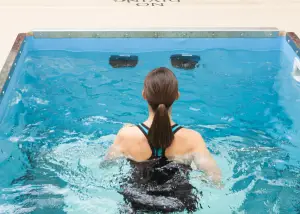
If you are dying to run but it’s still painful you can perform aquatic running. Many recreation centers have “lazy rivers” and you can run against the current in the pool to take pressure of the knee but still get a good cardio workout.
Once your symptoms have resolved and you can perform a pain-free single-leg squat, then you can begin to transition back to running at a gradual time frame.
Can You Cause more Damage to Knee Bursitis?
There is always a risk of further damage to an injury, however, patella bursitis typically heals well with appropriate conservative treatment.
In most cases, patellar bursitis will heal within a few weeks. However, if the bursitis is continually irritated, this can increase the length of time for recovery.
In most instances you are not making the knee bursitis any worse or causing damage, it’s simply painful. You can work through mild discomfort without having to worry about making things worse.
However, we have seen severe cases where mild bursitis was made into a severe case when the person jumped and landed on her bursa.
This causes the bursa to swell to extreme sizes and took a long period of time to return back to normal size. This can cause issues with the quad muscle, sitting, and even sleeping because you bump it on the other leg or bed in the night.
Why Do Stairs Hurt After Bursitis in the Kneecap?
When you have patella bursitis, stairs can be a big challenge. This is because descending stairs place direct pressure on the patellar bursa, which can cause pain and irritation of the bursa.
The force on the quad muscles and the patella bursa as you descend stairs is higher than you might guess, even more force than lunges.
An easy way to avoid this is to take one step at a time when going downstairs. You may also want to hold onto the railing for support and take pressure off the injured knee.
Wearing a knee compression sleeve is often enough to support that you can perform stairs without any increase in pain or other symptoms. This can make stair navigation pain-free and limit the amount of swelling increase at the end of the day.
Tips for Speed Up Recovery from Patella Bursitis
There are a few things that you can do to speed up your recovery from patella bursitis.
Stay Active, Don’t Avoid all Activity
As we mentioned earlier, staying active is key in recovering from patella bursitis. Find activities that don’t aggravate your symptoms and slowly add more activity as you start to feel better.
Ice the Knee
Apply ice to the affected area for 15-20 minutes several times a day. This will help to reduce inflammation and pain. This helps numb the nerves that supply pain signals to the bursa.
Modify Activities
This can be difficult to do especially if your job requires you to do activities that aggravate the bursa, but it is essential for healing.
Try to limit activities that aggravate your symptoms and give your body time to heal. You may have to take it easy on weekend sports or modify your work duties.
It’s not the end of the world if have to wear a knee pad for 3 weeks or if you have to carry around a knee pillow for kneeling. This will help speed up recovery and your co-workers will forget about it quickly.
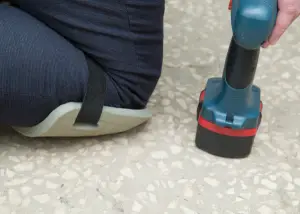
As an example, if you have patella bursitis and have to kneel down, ask your boss if you can use a stool to sit on instead of kneeling or see if there are other duties that you can do for a few weeks until it heals.
Knee Compression Sleeve for Bursitis
Wearing a knee compression sleeve can help to support the knee and reduce swelling. Compression can help stabilize the knee and also pump the swelling out of the bursa as well as help prevent more from entering the knee.

We recommend using a closed patella compression sleeve such as the McDavid Neoprene Knee Sleeve. If you use an open patella compression sleeve this can actually push more swelling to the bursa itself because of the opening and cause the kneecap to look like an egg.
Hip-Strengthening Exercises
Weak hips can cause increased stress on the patellar bursa due to poor alignment control of the knee. The knee is reliant on the hip for maintaining a straight line from your hip to your ankle. If you have weak hips, then it places more pressure on the knee and it will consistently be overloaded.
Doing hip-strengthening exercises can help to improve stability and reduce your risk of patella bursitis by limiting the amount of high forces in the knee cap.
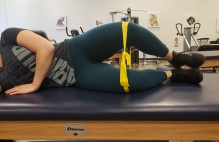
Some of the best hip-strengthening exercises for patella bursitis include the side-lying clamshell, 3-way banded hip exercises, and single-leg bridges.
Light Quad Strengthening Activities
Once you start to feel better, you can add light quad strengthening activities to your routine. This will help in many ways including limiting the amount of atrophy in the quad muscle, pumping swelling out of the bursa, and helping calm down nerves in the knee.
You’ll be surprised at how quickly weakness will set into the knee with even a few weeks’ rest.
Safe quad strengthening exercises to do for patella bursitis are knee extensions, single-leg leg press, reverse lunges, and holding a single leg balance with your knee bent for 30 seconds.
Conclusion
In this blog post, we discussed what to avoid when you have patella bursitis. It’s best to avoid being sedentary, kneeling, heavy deep squats, and repetitive motions that cause bursal irritation.
Stay active by finding activities that don’t aggravate your symptoms. If you have any questions, please don’t hesitate to ask us in the comments section below or if you have anything that helped your patella bursitis heal quickly let us know below.
How to Stay Active After Cervical Fractures: Expert Tips and Advice
Dealing with Painful Stairs After Ankle Replacement Surgery
Walking After a Total Ankle Replacement: Tips for a Successful Recovery
Exercises While Non-Weight Bearing After Ankle Replacement: Elevation, AROM, Leg Raises, and More
Ankle Pain with Stairs: Causes and Home Treatment Options
5 Common Mistakes You’re Making After an Ankle Sprain
Disclaimer: The information provided in this post is for educational purposes only. This is not a substitute for a medical appointment. Please refer to your physician before starting any exercise program.
